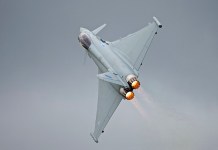Boeing is intensifying efforts to secure new contracts for its P-8A Poseidon maritime patrol aircraft (MPA) in Europe, driven by heightened Russian submarine activity in the region.
U.S. B-52 Bombers ‘Flex Muscles’ In Alaska As Chinese H-6, Russian T-95 Bombers ‘Heat-Up’ The Region
At the Farnborough International Airshow 2024, Tim Flood, Boeing’s senior regional director for international business development, highlighted the company’s strategy to expand its European footprint.
“Clearly, Russian submarine activity is driving a strong emphasis on the need for maritime patrol aircraft (MPA)—that is the underlying cause that is helping the cause of the P-8 as far as which new European countries are looking at it,” Flood told Janes.
Boeing is targeting Denmark, France, and Italy are key prospects for the P-8A Poseidon. France is expected to formally begin the acquisition of its next-generation maritime patrol aircraft (MPA) in 2026 to have the new aircraft operational between 2030 and 2040.
Earlier this year, however, Boeing noted that France had not yet approached the company regarding the purchase of P-8 Poseidon MPAs to replace its navy’s aging Atlantique 2 (ATL2) fleet. Instead, France is likely to collaborate with European firms to develop a successor to the ATL2.

Nevertheless, it is not impossible to find an off-the-shelf solution that combines local industry cooperation with national interests while maintaining cost-effectiveness.
Meanwhile, Flood pointed out that Denmark, in particular, is seeking an MPA solution as part of its 10-year defense strategy.
The Danish government is evaluating options to enhance its maritime surveillance capabilities in the Faroe Islands, Greenland, and the Arctic region. While Denmark’s decision is still pending, The P-8A Poseidon’s advanced features make it a strong contender.
“They need something that can meet their maritime patrol and their anti-submarine warfare [ASW] requirements,” Flood said. “We have been in active discussions with the Danes, and now it is within their own analysis and political determination process.”
The potential for broader regional collaboration also exists. Denmark could potentially join forces with neighboring Nordic countries—Finland, Norway, and Sweden—to field the P-8A Poseidon as part of a collective defense initiative.
“The fact that Norway already operates means there are some good Nordic collaboration opportunities as well,” Flood added.
Boeing Promotes P-8A Poseidon as Ideal Solution To Track Russian Subs
Boeing’s efforts to win European orders for the P-8A Poseidon are a strategic response to growing regional security concerns and the urgent need for an improved maritime surveillance system.
The impact of Russia’s invasion of Ukraine has highlighted the necessity for a strengthened security framework in northern Europe, prompting Finland and Sweden to seek out and join NATO.
In early 2023, a Norwegian intelligence report warned about Russia’s likely escalation of its presence in the Barents Sea and the Atlantic Ocean, along with extended submarine deployments.
The report detailed that Russia’s Northern Fleet would continue its regular fleet exercises, lengthen submarine patrols in the Barents Sea, and increase submarine operations in the Atlantic Ocean.
The report further noted that the introduction of new, silent multi-role submarines had boosted the fleet’s capabilities in the Norwegian Sea and the Atlantic Ocean.

The increased presence of Russian submarines has raised significant concerns about the security of sea lanes between North America and Europe, which are crucial for reinforcement in the event of war.
If one or more Russian submarines were to slip undetected into the Norwegian Sea, protecting these vital routes would become exceedingly difficult.
In such a situation, maritime patrol aircraft (MPA) play a crucial role in monitoring Russian submarines. Boeing markets its P-8A Poseidon as an ideal solution for addressing the maritime and anti-submarine warfare requirements of European nations, owing to its versatile mission capabilities.
The P-8 operates at 5,000 feet and 350 knots. Depending on the mission, it can also fly at 20,000 feet. Compared to the Lockheed P-3 Orion maritime surveillance aircraft, the P-8 offers a smoother flight at low altitudes.
One of the P-8 Poseidon’s key features is its 129 sonobuoys, which are crucial for submarine detection. These sonobuoys, packed in canisters, are deployed from the aircraft into the water, where they descend to a pre-programmed depth.
They transmit data via antennas above the surface to the aircraft’s onboard computers, where acoustic and electronic operators process the information.
When multiple sonobuoys are deployed, they emit acoustic waves underwater that bounce off submarine hulls, allowing operators to determine the submarine’s direction, distance, and depth.
The P-8 Poseidon’s advanced detection capabilities enable the crew to pinpoint and track submarine movements accurately, thereby enhancing maritime security and ensuring the protection of critical sea lanes.
- Contact the author at ashishmichel(at)gmail.com
- Follow EurAsian Times on Google News




